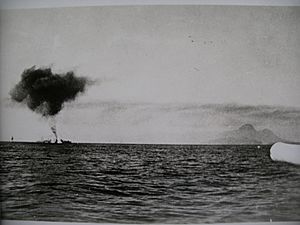Battle of Cape Spada facts for kids
Quick facts for kids Battle of Cape Spada |
|||||||
|---|---|---|---|---|---|---|---|
| Part of the Battle of the Mediterranean of World War II | |||||||
 Bartolomeo Colleoni sinking, 19 July 1940 |
|||||||
|
|||||||
| Belligerents | |||||||
| Commanders and leaders | |||||||
| Strength | |||||||
| 1 light cruiser 5 destroyers |
2 light cruisers | ||||||
| Casualties and losses | |||||||
| 1 wounded 1 light cruiser damaged |
121 killed 555 captured 1 light cruiser sunk |
||||||
The Battle of Cape Spada was a sea fight during World War II. It happened on July 19, 1940. This battle took place in the Mediterranean Sea, near Cape Spada off the island of Crete. It was part of the larger Battle of the Mediterranean.
Contents
Getting Ready for Battle
The battle began when Allied ships were patrolling the Aegean Sea. They met two Italian cruisers. These Italian ships were moving from Tripoli to Leros. Leros was an Italian colony at that time.
The Allied ships were led by Captain John Collins from Australia. He was on the light cruiser HMAS Sydney. The Allied group also had five British destroyers. These were HMS Havock, Hyperion, Hasty, Hero, and Ilex.
The Italian ships were two fast light cruisers. They were named Giovanni delle Bande Nere and Bartolomeo Colleoni. Vice Admiral Ferdinando Casardi commanded these Italian ships.
The Sea Fight Begins
The Italian cruisers first saw the Allied destroyers around 7:30 AM. At this time, Sydney and Havock were about 40 miles north. They were looking for submarines. The other Allied destroyers then led the Italian cruisers north. This gave Sydney time to come and help.
Sydney saw the Italian ships at 8:26 AM. It started firing its guns at 8:29 AM. The Italian cruisers then turned to the southwest.
Sinking of the Bartolomeo Colleoni
During the battle, Bartolomeo Colleoni was hit hard by Sydney. A shell went through its side, which was not heavily protected. This hit damaged its engines and guns at 9:23 AM. The ship could no longer move or use its main weapons.
Even though it was badly damaged, Bartolomeo Colleoni kept fighting. But it was finally sunk by three torpedoes. These torpedoes were launched by Ilex and Hyperion at 9:59 AM.
Sydney kept firing at Bande Nere. Sydney was hit once in its funnel. But it hit Bande Nere at least twice. Eight people on Bande Nere were killed.
Later, Sydney stopped fighting because it was running low on ammunition. Giovanni delle Bande Nere then went back to Benghazi. The battleship HMS Warspite and some destroyers followed it.
After the battle, 555 sailors from Bartolomeo Colleoni were saved. Sadly, 121 sailors died.
Why the Allies Won
The Italian cruisers were very fast. But they could not escape Sydney. They had to steer away from Crete. This meant they could not use their full speed to get away. This gave Sydney a chance to get closer.
The Italian ships, Colleoni and Bande Nere, had light armor. This armor could not stop the shells from Sydney. Also, the Italian ships did not have planes to scout ahead. This made it harder for them to know where the Allied ships were.
After the Battle
After the fight, Italian planes bombed the British destroyers. HMS Havock was damaged. Its second boiler room was flooded.
A plane from Warspite was looking for Bande Nere. This plane crashed into the sea near Tobruk. Its crew was captured by the Italians.
An Allied convoy, AN.2, was told to go back to Port Said. It stayed there until it was known that Bande Nere had reached Benghazi safely.
Ships in the Battle
Italy
- Rear Admiral Ferdinando Casardi - 2nd Cruiser Division
- Regia Marina: 2 light cruisers: Bartolomeo Colleoni (sunk), Giovanni dalle Bande Nere
Allies
- Captain John Collins - 2nd Destroyer Flotilla
- 1 light cruiser: HMAS Sydney
- 5 destroyers: HMS Hasty, Havock, Hero, Hyperion, Ilex
Images for kids




